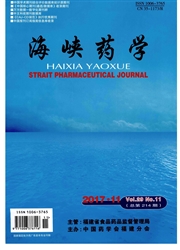

 中文摘要:
中文摘要:
目的:探讨乌头碱由心包经不同穴位点注射是否具有减弱其心脏毒性的作用。方法:正常新西兰兔按体重随机分为非经非穴(肌肉)注射组、心包经内关穴(内关)注射组、心包经曲泽穴(曲泽)注射组、心包经上非穴点(经上非穴)注射组、及正常对照组,除正常对照组外,其余各组按不同部位注射乌头碱30μg/kg,观察注射后15min、60min、120min心肌组织Na+-K+-ATP酶活力及血清高敏C反应蛋白(hs-CRP)浓度的变化。结果:乌头碱30μg/kg不同途径注射后15min心肌Na+-K+-ATP酶活力即已显著降低,hs-CRP浓度显著升高,60min、120min亦相似;与肌肉注射组比较,心包经上三个注射组三个时间点的Na+-K+-ATP酶活力则呈升高趋势,hs-CRP浓度呈降低趋势,内关组、曲泽组尤为显著。结论:乌头碱经由心包经穴位与非穴位点注射,可减缓新西兰兔心肌组织Na+-K+-ATP酶活力的下降,降低血清hs-CRP浓度升高的幅值趋势,正常机体心包经穴位组织在穴位注射中可能起着一定的心脏功能保护作用,减少外来物质的刺激作用。
 英文摘要:
英文摘要:
Objective:To explore whether injection into different points along pericardium meridian weakened the cardio toxicity of aconitine. Methods: Normal New Zealand rabbits,according to body weight,were divided into several groups by random: muscular group ( non-meridian and non-acupoints group) ,Neiguan group,Quze group,non-acupoint group,and normal control group. Except normal control group,other groups were injected with aconitine in different points at the dose of 30μg/kg. Then determining Na+-K+-ATPase activity in myocardial tissue and c-reactive protein ( HS - CRP) concentration in serum after 15 min,60 min and 120 min of injection. Results: Compared with normal control group,Na+-K+-ATPase activity of other groups significantly decreased,and hs-CRP concentration significantly increased( P 0. 01) ; compared with the muscular group,Na+-K+-ATPase activity of Neiguan,Quze and non-acupoint group ( especially Neiguan and Quze group) significantly increased,conversely,hs-CRP concentration significantly decreased. Conclusion: Injection into different acupuncture points or non-acupoint along pericardium meridian could slow down the trend of decline of Na+-K+-ATPase activity and raise of hs-CRP concentration in New Zealand rabbit. That meant acupoint injection along pericardium meridian played a role of protecting cardiac function and weakening the stimulation from outside.
 同期刊论文项目
同期刊论文项目
 同项目期刊论文
同项目期刊论文
 期刊信息
期刊信息
